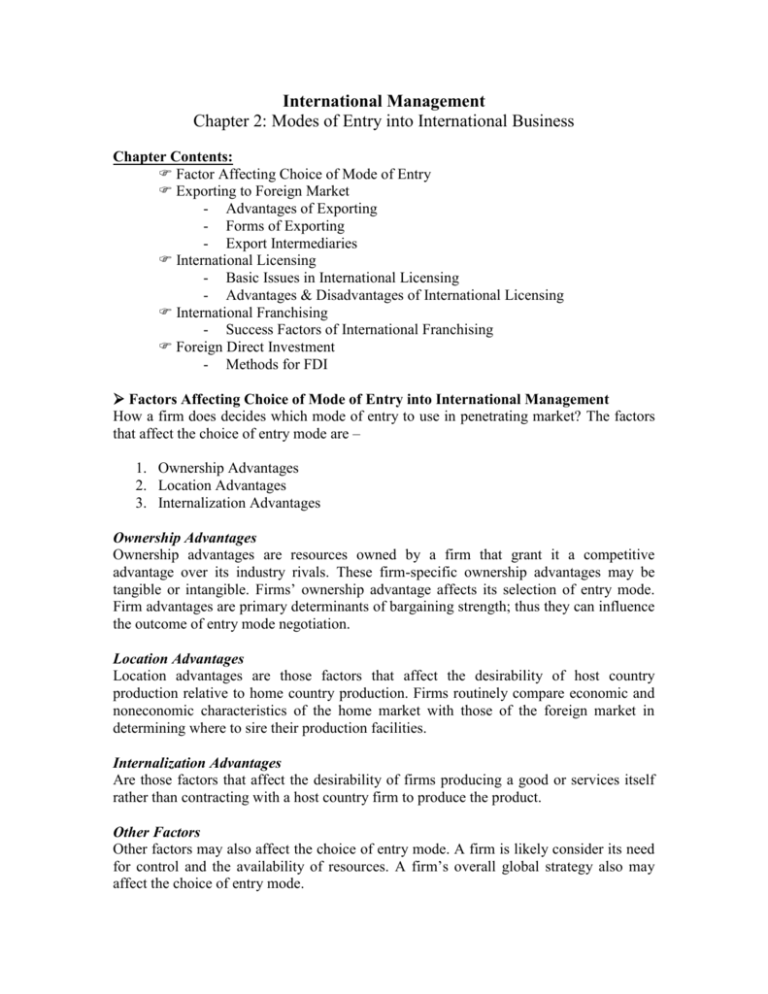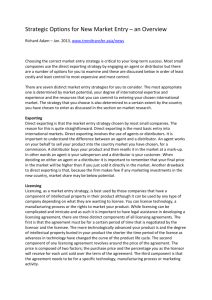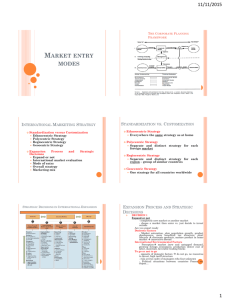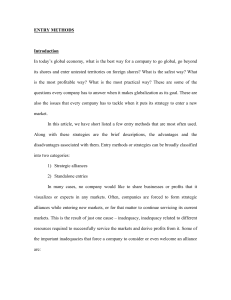International Business
advertisement

International Management Chapter 2: Modes of Entry into International Business Chapter Contents: Factor Affecting Choice of Mode of Entry Exporting to Foreign Market - Advantages of Exporting - Forms of Exporting - Export Intermediaries International Licensing - Basic Issues in International Licensing - Advantages & Disadvantages of International Licensing International Franchising - Success Factors of International Franchising Foreign Direct Investment - Methods for FDI Factors Affecting Choice of Mode of Entry into International Management How a firm does decides which mode of entry to use in penetrating market? The factors that affect the choice of entry mode are – 1. Ownership Advantages 2. Location Advantages 3. Internalization Advantages Ownership Advantages Ownership advantages are resources owned by a firm that grant it a competitive advantage over its industry rivals. These firm-specific ownership advantages may be tangible or intangible. Firms’ ownership advantage affects its selection of entry mode. Firm advantages are primary determinants of bargaining strength; thus they can influence the outcome of entry mode negotiation. Location Advantages Location advantages are those factors that affect the desirability of host country production relative to home country production. Firms routinely compare economic and noneconomic characteristics of the home market with those of the foreign market in determining where to sire their production facilities. Internalization Advantages Are those factors that affect the desirability of firms producing a good or services itself rather than contracting with a host country firm to produce the product. Other Factors Other factors may also affect the choice of entry mode. A firm is likely consider its need for control and the availability of resources. A firm’s overall global strategy also may affect the choice of entry mode. Exporting to Foreign Markets Perhaps the simplest mode of internationalizing a domestic business is exporting, the most common form of international business. Exporting is the process of sending goods or services from one country to other countries for use or sale there. Advantages of Exporting Exporting offers several types of advantages – 1. It often involves less financial exposure than do some entry mode. 2. Exporting permits a firm to enter a foreign market gradually, thereby allowing it to assess local conditions and fine-tune its products to meet the idiosyncratic needs of host country consumers. 3. Firms may have proactive or reactive motivations for exporting. Proactive motivations are those that pull a firm into foreign markets, as a result of opportunities available there. Reactive motivations for exporting are those that push a firm into foreign markets, often because opportunities are decreasing in the domestic markets. Forms of Exporting Export activities may take several forms: 1. Indirect Exporting Indirect exporting occurs when a firm sells its product to a domestic customer, which in turn exports the product, in either its original form or a modified form. Some indirect exporting activities reflect conscious actions by domestic producers. 2. Direct Exporting Direct exporting involves sales to customers – either distributors or end users – located outside the firm’s home country. Research suggests that in one third of cases, a firm’s initial direct exporting to a foreign market is the result of an unsolicited order. 3. Intracorporate Transfers A third form of export activity is the intracorporate transfer which has become more important as the sizes of MNCs have increased. An intracorporate transfer is the selling of goods by a firm in one country to an affiliated firm in another. Export Intermediaries An exporter may also market and distribute its goods in international markets by using one or more intermediaries, third parties that specialized in facilitating imports & exports. Types of intermediaries that offer a broad range of services include the following – 1. Export Management Companies An export management company (EMC) is a firm that acts as its client’s export department. Smaller firms that often use EMC to handle their foreign shipments. An EMC’s staff typically is knowledgeable about the legal, financial, and logistical details of exporting and importing and so frees the exporter from having to develop this expertise in-house. The EMC may also provide advice about consumer needs and available distribution channels in the foreign markets the exporter wants to penetrate. 2. International Trading Company An international trading company is a firm directly engaged in exporting and importing a wide variety of goods for its own account. It differs from EMC in that it participates in both exporting and importing activities. By buying goods in one country and selling them in a second, an international trading company provides the gamut of necessary exporting and importing activities. 3. Manufacturers’ Export Agents Act as an export department for domestic manufacturers, selling those firms goods in foreign markets. 4. Exports and Imports Brokers Exports and imports brokers bring international buyers and sellers of such standardized commodities as coffee, cocoa, and grains. 5. Freight Forwarders Specialize in the physical transportation of goods, arranging customs documentations and obtaining transportation services for their clients. International Licensing Another means of entering a foreign market is licensing, in which a firm, called the licensor, sells the right to use its intellectual property – technology, work methods, patents, copyrights, brand names, or trade marks – to another firm, called licensee, in return for a fee. Issues of International Licensing Issues this contract typically addresses include the following: 1. Specifying the Agreement’s Boundaries The first step in negotiating a licensing contract is to specify the boundaries of the agreement. The firms involved must determine which rights ad privileges are and are not being conveyed in the agreement. 2. Determining Compensation Compensation is another basic issue that is specified in a licensing contract. Obviously, the licensor wants to receive as much compensation as possible, while the licensee wants to pay as little as possible. Yet each also wants the agreement to be profitable for the other so that both parties will perform their contractual obligations. 3. Resolving Disputes The licensing agreement should also detail how the parties will resolve disputes and disagreements. 4. Specifying the Agreement’s Duration The last part of the licensing agreement usually specifies its duration. The licensor may view licensing agreement as a short-term strategy designed to obtain low-cost, low-risk data about the foreign market. Advantages & Disadvantages of International Licensing Advantages for Licensor 1. Licensing carries relatively low financial risk. 2. It provides the licensor sully investigates its market opportunities and the abilities of its licensee. 3. It also allows the licensor to learn about the sales potential of its products and services in a new market without significant investment in financial and managerial resources. Advantages for Licensee 1. Licensee benefit through the opportunity to make and sell, with relatively little R&D cost, products and services that have been successful in other international market. 2. The licensee, by producing under the licensing agreement, may be able to learn the manufacturing secrets of the licensor. Disadvantages 1. However, licensing does have opportunity costs. Licensing agreements limit the market opportunities for both the parties. 2. Licensor and licensee mutually depend on each other to maintain product quality and to promote the product’s brand image. 3. Improper actions by one party can damage the other party. 4. No matter how carefully worded a licensing agreement may be, there is always the risk of problems and misunderstandings. International Franchising Still another popular strategy for internationalizing a business is franchising. Essentially a special form of licensing, franchising allows the licensor more control over the licensee and provides for support from the licensor to the licensee. Success Factors in International Franchising International franchising is likely to succeed when certain market conditions exist: 1. A franchisor has already achieved considerable success in franchising in its domestic market. 2. The firm has been successful domestically because of unique products and advantageous operating procedures and systems. 3. The factors that contributed to domestic success should be transferable to foreign locations. 4. There must be foreign investors who are interested in entering into franchise agreements. Foreign Direct Investment (FDI) Many firms prefer to enter international markets through ownership of assets in the host countries. Methods of FDI There are three methods of FDI – 1. The Greenfield Strategy The Greenfield strategy involves starting a new operation from scratch. The Greenfield strategy has several advantages: a. The firm can select the site that best meets its needs and construct modern, upto-date facilities. b. The firm starts with a clean slate. c. The firm can acclimate itself to the new national business culture as its own pace, rather than having the instant responsibility of managing a newly acquired, ongoing business. However, the Greenfield strategy has some disadvantages: a. Successful implementation takes time and patience. b. Often land in the desired location is unavailable or very expensive. c. In building the new factory, the firm must company with various local and national regulations. d. The firm must recruit a local workforce and train it to meet the firm’s performance standards. e. The firm, by constructing a new facility, may be more strongly perceived as a foreign enterprise. 2. The Acquisition Strategy (Brownfield Strategy) A second FDI strategy is acquiring of an existing firm conducting business in the host country. Although the actual transaction may not doubt by very complex involving bakers, lawyers, regulators, and mergers and acquisition specialists from several countries. However, the acquisition firm also assumes all the liabilities – financial, managerial, and otherwise – of the acquired firm. 3. Joint Venture Another form of FDI is the joint venture. Joint ventures are created when two or more firms agree to work together and create a jointly owned separate firm to promote their mutual interests. The number of such arrangements in burgeoning as rapid changes in technology, telecommunications, and government policies outstrips the ability of international firms to exploit opportunities on their own.







